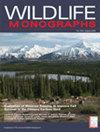Long-term demography of the Northern Goshawk in a variable environment
Abstract
The Nearctic northern goshawk (Accipiter gentilis atricapillis) is a resident of conifer, broadleaf, and mixed forests from the boreal to the southwestern montane regions of North America. We report on a 20-year mark-recapture investigation (1991–2010) of the distribution and density of breeders, temporal and spatial variability in breeding, nestling sex ratios, local versus immigrant recruitment of breeders, breeding age structure, age-specific survival rates, and rate of population change (λ) of this species on the Kaibab Plateau, a forested sky island in northern Arizona, USA. We used an information-theoretic approach to rank models representing alternative hypotheses about the influence of annual fluctuations in precipitation on the annual frequency of goshawk breeding and fledgling production. We studied 125 goshawk breeding territories, representing approximately 87% of an estimated 144 total territories based on a mean distance of 3.8 km between territory centers in a 1,728-km2 study area. The salient demographic feature of the population was extensive annual variation in breeding, which manifested as large inter-annual variation in proportions of pairs laying eggs, brood sizes, nest failure rates, and fledgling production. The percent of territories known in a prior year in which eggs were laid in a current year ranged from 8% to 86% ( = 37%, SE = 4.51), annual mean nest failure rate (active nests that failed) ranged from 12% to 48% (overall = 23%, SE = 2.48), and mean annual brood size of successful nests (fledged ≥1 fledgling) ranged from 1.5 young to 2.5 young (overall = 2.0 young, SE = 0.03). Inter-annual variation in reproduction closely tracked inter-annual variation in precipitation, which we hypothesize influenced primary forest productivity and bird and mammal prey abundance. The best breeding years (1992–1993, 77–87% of pairs laid eggs) were coincident with a record-long El Niño-Southern Oscillation (ENSO) wet period and the worst breeding year (2003; 8% of pairs laid eggs) was the last of a 3-year record drought. Overall breeding success was 83% with most failures occurring during incubation; once eggs hatched, goshawks tended to fledge young. The pooled 20-year nestling sex ratio did not differ from unity (53% M; n = 410 M, 366 F) but was significantly male-biased in 2 years and female-biased in 1 year. Nonetheless, the overall greater production of male fledglings followed a strong trend of greater male production in other goshawk populations, suggesting that breeders might have been adaptively adjusting their offspring sex ratio, perhaps to produce more of the rarer (male) sex. Annual recruitment of new individuals into the breeding population averaged 43% during the study. Study area recruitment rate of hawks locally born (in situ) and banded was 0.12. Both sexes had equal tendencies to return to the Kaibab Plateau to breed (no differences in philopatry) and there were no differences in natal dispersal distances (natal to first breeding site) between the sexes. During the final years of study (1999–2010), an estimated 46% of breeding recruits were locally born and 54% were immigrants from distant forests. Minimum age at first breeding was 2 years and mean age at first breeding by known-age hawks (banded as nestlings or aged on plumage at first breeding) was 3.7 years for males and 3.5 years for females. Mean lifespan (yr from first banding as nestling to last resighting) of known-age goshawks was 6.9 years for both sexes. Mean minimum apparent lifespan of breeders aged ≥4 years based on plumage at first capture was 6.5 years for both sexes. Average age of goshawks at their first detection was 3.9 years old, at which time apparent survival was estimated at 0.77 for both sexes, which was just slightly less than the peak survival of 0.78 as a function of age. Age-specific survival estimates showed a steady decline after 9 years old and approached 0 at 20 years of age. Estimates of λ for breeding adults (M, 0.94, SE = 0.037; F, 0.98, SE = 0.038) provided only weak evidence for a population decline during the study. Although sex was not in the top survival model, models including age + sex were competitive, evidencing lower male than female survival, a finding corroborated by the occurrence of sex effects in the top λ model. Lower male survival may result from higher mortality associated with hunting agile prey in vegetation-filled environments during long breeding seasons when they are the primary forager. Lower survival may be compensated by the more frequent production (53%) of male fledglings. High-severity crown fire was an existential threat to the population. In addition to 4 large high-severity fires that burned roughly 3,770 ha (equal to 3 goshawk territories) in the 30 years preceding 1991, 6 high-severity fires burned another 30,945 ha during our study and killed most (>64%) of the forests in 8 known territories and possibly another 2 that were burned before we completed surveys.
Based on a lack of any recent demographic perturbations in age structure, a relatively high and time-constant annual adult survival rate, confidence intervals around adult λ estimates overlapping 1.0, and a study area saturated with territories, we surmise that the goshawk population on the Kaibab Plateau was stable during the 20-year study. Nonetheless, uncertainty remains regarding the population's future status because of a declining trend in breeding frequency, uncertain status (dead, alive, emigrated) of non-breeding adults, extensive temporal and spatial variation in breeding, and high frequency of immigrant recruits to the breeding population on the Kaibab Plateau. If the century-long decline in precipitation persists, especially at the increased rate seen since 1980, and manifests as deeper droughts, diminished wet periods, and weaker pulses in forest productivity, then the Kaibab Plateau goshawk population would be expected to show unambiguous evidence of decline. Evidence would include reduced local and regional goshawk reproduction and survival, reduced frequency of immigration, and further habitat loss to catastrophic fire. © 2017 The Wildlife Society.

 求助内容:
求助内容: 应助结果提醒方式:
应助结果提醒方式:


